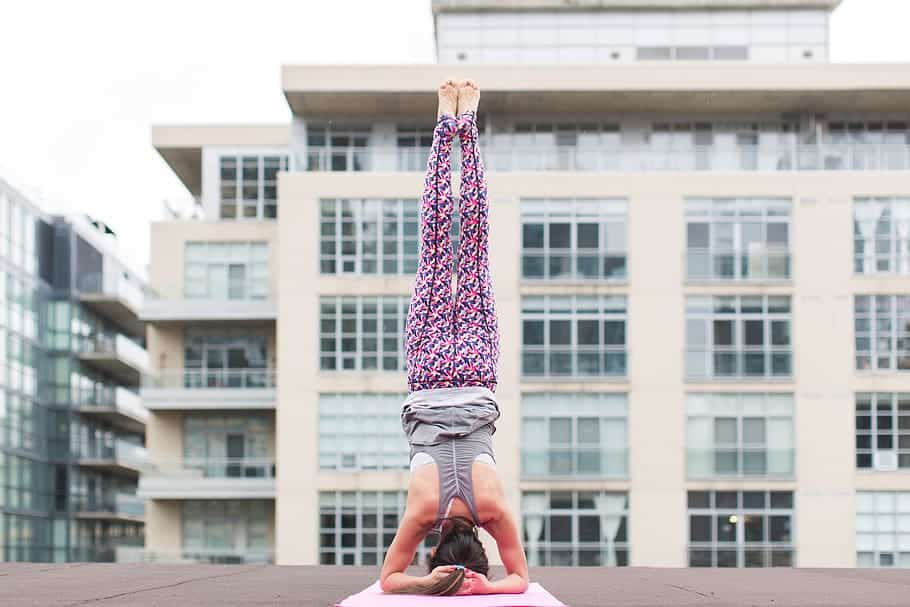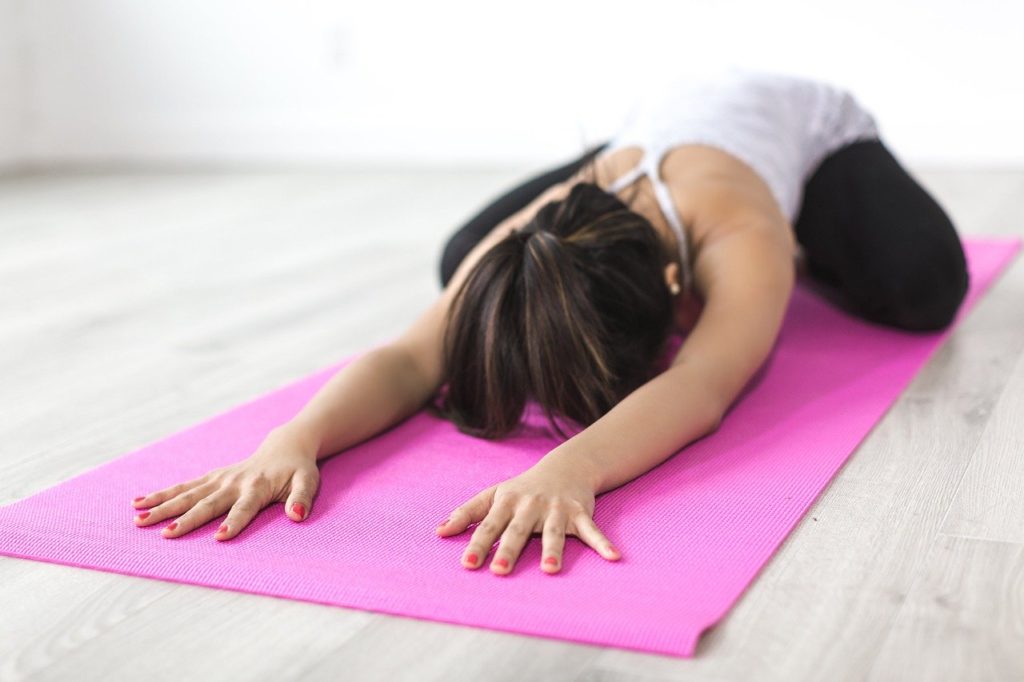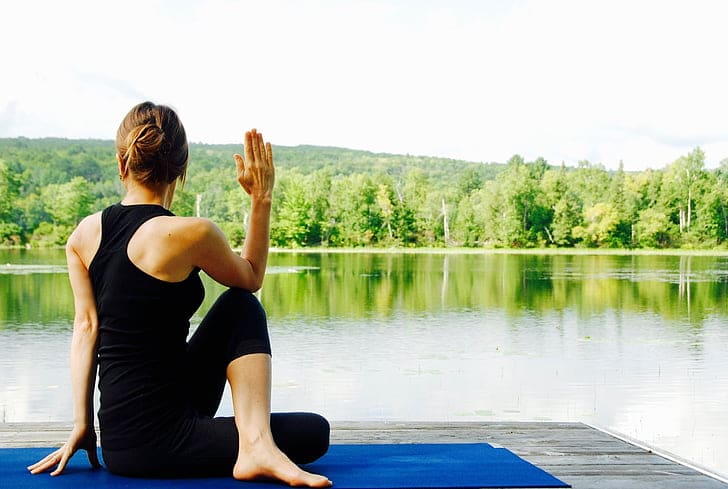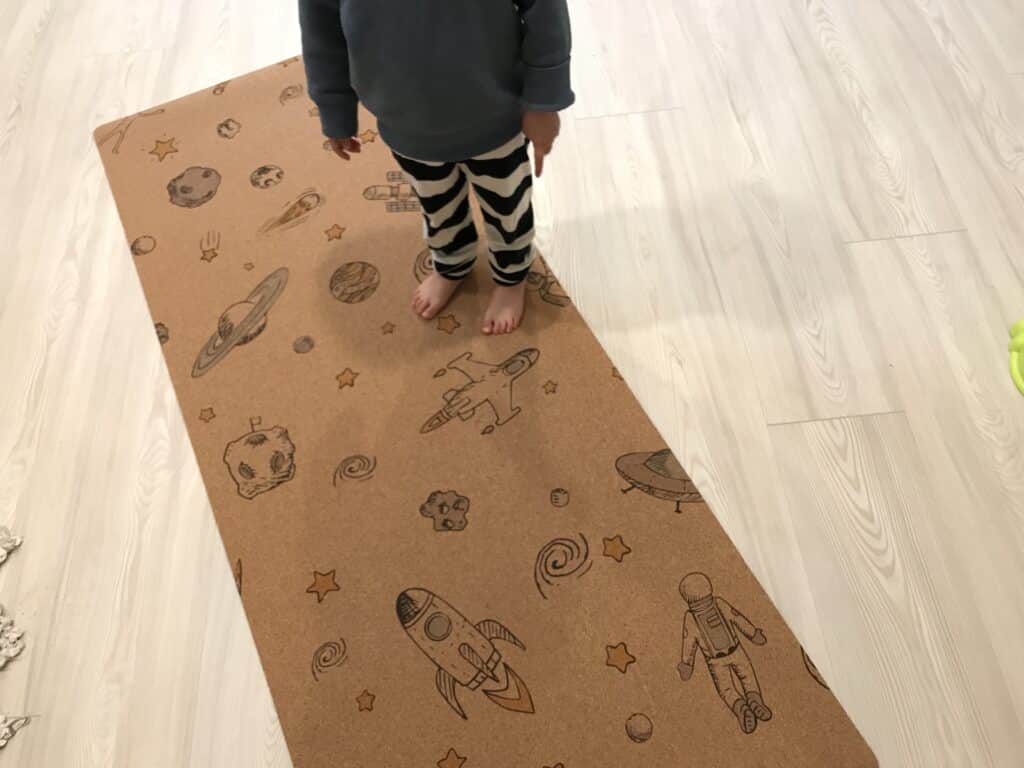Have you heard of the ‘yoga mat chemical’? Make sure ADA and other toxic chemicals in your mat aren’t souring your serenity.

Love it or hate it, that ‘new yoga mat smell’ may be bad for your health. While some natural yoga mats have a perfectly benign ‘new’ smell, this smell can also result from off-gassing of toxic chemicals.
Below, I look at what to avoid in conventional yoga mats, taking aim at the worst offenders and highlighting greenwashing in the yoga mat industry.
The ‘yoga mat chemical’: Azodicarbonamide
Known as the ‘yoga mat chemical’, azodicarbonamide (ADA) is a synthetic chemical with a crystalline structure at room temperature and a yellow-orange color.
ADA is predominantly used in the rubber and plastic industries as a chemical foaming agent. When it is mixed into polymer plastic gel it creates tiny gas bubbles, resulting in PVC, polyolefins, and natural and synthetic rubbers that are strong, light, spongy and malleable.
ADA is also used in beer-making processes and is added to cereal flour for its whitening effect and to bread flour to remove the need for traditional proofing where natural yeast is used to make bread rise. As such, many fast food restaurants and bakeries make bread and other baked goods with ADA.
In the U.S., ADA is still used in a wide variety of products, including food. Despite campaigns in recent years calling for Subway, Wendy’s, McDonalds, and other companies to stop using the chemical, according to Environmental Working Group, ADA is still present in hundreds of supermarket items.
Production of the chemical and its use in foods is banned in the European Union and Australia, although it may still be imported for use in non-edible products. In Singapore, companies who use ADA are subject to massive fines and even jail time.
VOCs and PAHs

Chemicals such as volatile oil compounds (VOCs) and polycyclic aromatic hydrocarbons (PAHs) are emitted as a breathable gas from PVC yoga mats, as well as from:
- Carpets
- Furnishings
- Paint
- Cleaning supplies
- Printer ink
- Other household products.
The use of toxic chemicals in conventional household products can mean that concentrations of VOCs inside the house (and the yoga studio) can be ten-fold higher than outdoors.
VOCs also include a variety of chemicals used as:
- Antimicrobial treatments (increasingly common in yoga mats)
- Stain and soil repellents
- Anti-static treatments
- Adhesives
- Artificial dyes
- Flame retardants like organophosphate flame retardants (PFRs).
Phthalates, PVC, and synthetic latex
Phthalates are another chemical often found in yoga mats. This chemical is used to make PVC flexible, but it has been shown to leach out of materials when they become warm, making it a particular problem for anyone doing Bikram yoga. Phthalates can attach to dust and are then breathed in. Phthalates have been linked to a range of troublesome health issues.
Even if your yoga mat has a ‘natural’ surface, the backing, padding, or bulk of the mat might be made of synthetic latex (a suspected carcinogen) or vinyl, urethane, 4-phenylcylclohexene, or PVC.
And, even if a mat itself isn’t riddled with toxins, it may have been manufactured using harmful chemicals like:
- Chlorine gas
- Ethylene dichloride
- Vinyl chloride
- Mercury
- Dioxins.
These nasties can harm workers and are often released into the environment to do further damage. This is especially problematic in countries where environmental and worker safety regulations are lacking.
Polyester
Some companies have started using polyester in yoga mat construction, claiming that this is healthier than PVC. While they’re right in some senses, what they fail to acknowledge is that polyester production is energy intensive, leading to significant greenhouse gas emissions. Polyester yoga mats can mean more of the following pollutants:
- Carbon dioxide
- Nitrous oxide
- Hydrocarbons
- Sulfur oxides
- Carbon monoxide
- Acetaldehyde
- 1,4-dioxane (another potential carcinogen).
Polyester production also generates water-borne emissions, including dissolved solids, acids, iron, and ammonia. So, even though a polyester product may be labeled as ‘green’, this is likely less to do with the environmental impact and more to do with the end product not off-gassing toxic chemicals.

The environmental impact of yoga mats
Sadly, more common certifications such as Oeko-Tex 100 do not factor in the impact of manufacturing processes and only assess the end product. Oeko-Tex 1000 is better, but few fabric manufacturers carry this certification.
Some of the nasties found in yoga mats or involved in their production include:
- Azodicarbonamide (ADA)
- Phthalates
- Parabens
- PFRs
- Polypropylene
- Formaldehyde
- Benzene
- Pesticides, herbicides, and fertilizers (in ‘natural’ fiber mats)
Minimizing toxicity from yoga mats means choosing a mat made with natural materials free from potentially harmful chemical residues. There are other reasons, aside from possible toxins, to avoid synthetic materials and choose natural, organic yoga mats. Supporting this kind of organic agriculture is one of the best ways to fight climate change and encourage biodiversity.
Materials – what are yoga mats made of?
Yoga mats continue to be made predominantly with polyvinyl chloride (PVC). This synthetic material is cheap, usually fairly durable, has good ‘stickiness’ to reduce slippage, and also provides good ‘give’ or ‘sponginess’, for added comfort.
Unfortunately, PVC is rather toxic. If you plan to do yoga with your toddler or child using a mat, I strongly suggest avoiding PVC as this material can cause adverse health effects (see: PVC in crib mattresses).
PVC is also not eco-friendly. Per stats from TreeHugger.com:
| Per kg of PVC produced | For a 3 lb. yoga mat |
|---|---|
| 17 kg of abiotic materials, mostly petrochemicals | 23 kg of petrochemicals and minerals |
| 680 liters of water | 925 liters of water |
| 11.6 kg of air, which becomes greenhouse gases and other gases. | 15.8 kg of air |
Add to that the energy involved in shipping the raw materials (petroleum) around the world and shipping the mat to you, and an organic cotton mat made and shipped from India, or a natural rubber mat from Taiwan, starts to look even better.

TPE and PER – Greenwashed yoga mats
Watch out for yoga mats promoted as eco-friendly and non-toxic but made with petroleum materials such as PER (Polymer Environmental Resin) or TPE (Thermoplastic Elastomer).
These materials may be better than PVC in terms of energy use, but they are not natural and typically contain a variety of toxic chemicals.
What is TPE?
TPE is a synthetic material that can comprise rubber, plastic, a mixture of the two, or something else entirely. The big selling point of TPE for yoga mats seems simply to be that it’s not PVC.
Mat manufacturers often promote TPE as being free of:
- Bisphenol-A (BPA)
- PVC
- Lead
- Phthalates
- Dioxins
- Some other problematic chemicals.
The trouble is, TPE mats can still leach synthetic estrogens, especially when exposed to high temperatures, humidity, and sunlight (as yoga mats often are, particularly in Bikram).
I found one ‘green’ TPE yoga mat from Kulae, made using styrene-butadiene-styrene block copolymers (SBS).
Huh?
To me, this sounds very much like a composite of:
- Styrene – a possibly carcinogenic material made from ethylbenzene
- Butadiene – another potentially carcinogenic material, made from carbon and hydrogen in an energy intense steam cracking process requiring temperatures as high as 900 degrees Celsius.
This ‘green’ TPE yoga mat, then, is likely to be just as damaging to people and planet as a PVC mat that’s far cheaper.
Indeed, researchers at the University of Texas-Austin found that almost all commercially available plastics (including TPE) leached synthetic estrogens. Some of the BPA-free plastics actually released synthetic estrogens that were more potent endocrine disruptors than BPA itself (Bittner, CertiChem).
And because mat manufacturers rarely reveal the precise nature of the TPE in their products, we can’t be certain of their safety.

Jade advertises its yoga mats as non-toxic and eco-friendly.
Unfortunately, a German agency found that Jade mats contained nitrosamines (chemicals linked to cancer). The company said it has revised its manufacturing processes, but no additional third-party testing has been conducted.
I decided not to include Jade Harmony yoga mats in my recommended products in part because of these test results and because the company closely guards the exact make-up of its mats, only stating that they contain natural and man-made materials and are free from PVC, heavy metals, and phthalates.
If Jade changes its tune, I may add in the Harmony Yoga Mats as these are one of the few yoga mats to meet the performance needs of most practitioners while being PVC-free and (likely) relatively non-toxic.
All this said, if you have been coveting a Jade Mat, or even a Liforme or Manduka Pro Mat, and not having the mat means you’re practicing yoga less, get the mat. After all, it is almost certainly better for your health to practice yoga, even on a mat that may have some degree of undesirable environmental and health impact than it is to not practice and instead feel stressed and unhealthy through lack of exercise.
Natural yoga mat materials

Natural yoga mat materials make it easier to get into your flow, given that you won’t be worrying about inhaling toxic gases or ruining the planet.
Here’s a quick breakdown of yoga mat materials:
| Organic cotton | Organic wool | Jute |
|---|---|---|
| Excellent for sweat absorption | Excellent grip | Decent grip |
| Okay grip in Bikram | Superb comfort | Naturally antimicrobial |
| Not so good for ‘give’ or ‘sponginess’ | Naturally antimicrobial | Often blended with Polymer Environmental Resin (PER) to provide extra grippiness |
| Often easy to clean and store | Naturally insulating (great for cold yoga studios!) | |
| Biodegradable at end of life | Naturally flame-retardant | Not much give |
| Don’t deteriorate in direct sunlight or heat | Biodegradable at end of life | |
| Can last 15 years or more! | ||
| Can be upcycled at end of life |
| Cork | Recycled rubber | Natural rubber |
|---|---|---|
| Excellent for sweat absorption | Decent grip | Decent grip (closed cell can be slippery though) |
| Fantastic grip in Bikram | Good comfort | Naturally antimicrobial |
| Naturally antimicrobial | Not suitable for those with latex allergy | Cushioned and comfortable |
| Biodegradable at end of life | May contain heavy metals and toxic chemicals | Good support |
| Easy to keep clean | Biodegradable at end of life | |
| Can crack without proper care and handling | Deteriorate in direct sunlight and heat | |
| Choose open or closed cell surface to suit your practice |
Final thoughts
Now you know what to avoid in yoga mats and how to choose a material or combination that works for your practice, check out these fantastic yoga mats – eco-friendly, non-toxic, and tried and tested by the LeafScore team!
I just recently purchased a new Yoga mat from DICK’S Sporting Goods Store a brand name Adidas. So my question is: Is it safe for me to use it ? I’ve been reading all these articles here that some yoga mats are toxic and can cause a cancer? Please your respond is appreciate it.
Thank you.
Hi Romeo,
It looks like the Adidas yoga mats are made with PVC, so they would bring with them the environmental and chemicals risks associated with that material, yes.
If you can get a refund or exchange, consider switching your practice to use one of these yoga mats instead: https://www.leafscore.com/eco-friendly-fitness-products/5-best-eco-friendly-yoga-mats/
Thanks,
Leigh
I was thinking of buying a cork yoga mat. I noticed that most are made with a TPE lining between the floor and the cork. I assume the lining is needed to hold the cork together as well as provide cushioning? Is the toxicity exposure to TPE considerably minimized by a cork layer? When on the floor, only the edges are exposed to the air. Could you also minimize exposure by avoiding touching the floor side down?
Hi Rich,
It’s not necessary to use TPE to hold cork together or bind it to a backing. Nevertheless, TPE is a common material in ‘natural’ yoga mats. You can definitely minimize exposure by not touching the TPE layer and it’s also a good idea to maintain the mat well, so as to limit any leaching of chemicals.
Leigh
Are liforme mats free of any of the toxins mentioned in your article? They use eco polyurethane but not sure what’s that. Thanks.
Hi Iris,
Liforme yoga mats present a bit of a puzzle. They may be as eco-friendly as the brand makes them out to be, or they might be just a souped up polyurethane foam mat like those sold by many other brands.
Liforme mats are made with natural rubber and ‘eco polyurethane’ which is created using water as a blowing agent (eco-friendly) and metal catalysts (according to this report). The problem is, Liforme don’t specify their raw material for the polyurethane. This means that it could still be a petroleum-derived product. It is likely, though, that they use a biobased raw material, possibly vegetable oil, to create the polymer, but they’re just not transparent about it, which raises a red flag for me. They also don’t specify what kind of dyes they use to color the mats. And, interestingly, a report from EcoCenter found that the Liforme mat contained a layer of polyester between the rubber and polyurethane, which the company certainly doesn’t reveal in product listings. Polyester is not eco-friendly, though it is less toxic than PVC.
The first report I linked to above (which was commissioned by Liforme but seems credible) also notes that the mat is expected to biodegrade within 1-5 years in normal landfill conditions, although this hasn’t been verified.
So, all in all, I’m hesitant to recommend Liforme mats as there are just much better options out there that seem genuinely eco-friendly and non-toxic, without a hint of greenwashing. You can check out the LeafScore top picks for yoga mats here.
Thanks for the great question!
Leigh
Hi, this is great information thank you.
I was looking at this Holi Jute yoga mat on Amazon. Do you think this is a good option?
Hi Emily,
There’s very little information on the Holi mat and what is there seems rather incomplete and hyperbolic. Without seeing proper materials specifications, I can’t recommend this one, no.
We have rounded up our top picks for yoga mats here though, so hopefully one of these will work for your needs.
Thanks!
Leigh
Got a ENERGETICS 6P FREE PVC 5mm MAT for Christmas. Excitedly opened it my wife had a severe Asthma attack. The gassing off even got me BAD. I ran it out to garage and here we are 3 days later still stinks! (Takes ones breath away) It is made in CHINA distributed by INA International Ltd. Calgary, Ab CANADA it was bought at Sportcheck where it will be going back to COST 19.99.
Thanks for sharing this useful information. But, I have two questions.
1. Which yoga mats are made of toxic and harmful materials? Can you tell me the list of yoga mats that are made of PVC, TPE, Polyester and other materials that may cause cancer and other health problems?
2. I have seen a video from YouTube that shows the production of slipper from rubber sheet. It was my interest to produce slipper from rubber sheet. But, I couldn’t find rubber sheet at all. So, is it possible to produce a slipper from YOGA MATS? What is the difference between rubber sheet and Yoga mats?
Hi Molla,
Unfortunately, there are just so many yoga mats on the market these days that it’s pretty much impossible to list every single one that’s made of PVC etc.! The better option is to look at those that are made with natural materials and are non-toxic. A much faster search! Or, check out our recommended yoga mats that are PVC-free: Say Namaste to the 5 Best Eco-Friendly Yoga Mats
I haven’t come across slippers made with rubber sheeting, but I would imagine that you could definitely repurpose an old natural rubber yoga mat as material for the soles of slippers. It’s a great idea! Someone with more sewing skills than me would need to figure out how to stitch the soles to an upper though. Let us know if you find anything like that – we’d love to feature such things!
Thanks,
Leigh
Hi there I saw that you said that TPE was bad but the yoga mat with the most leafs has TPE is is it safe to use or should I be avoided?
Hi Alex,
Thanks for the comment and question. I’m not sure which mat you’re referring to as our top pick doesn’t have TPE. Maybe there’s a bit of confusion – as I mention in the review: “Gurus offer two Natural Cork Mat options, the Roots Yoga Mat which has a natural rubber base layer, and the Sprout mat that is made with TPE. As such, the Roots Mat makes the Leaf Score cut, but the Sprout does not.”
I’d avoid TPE if possible, and choose a mat where any TPE is on the base layer only, not in contact with skin otherwise. If you do hot yoga, I’d definitely avoid any plastics as hot, humid conditions are more likely to lead to leaching of chemicals from plastics.
Hope this helps clarify things!
Leigh
There are hundreds of products that we use on the daily that are made out of PVC and Vinyl. Are there no manufacturing regulations when it comes to yoga mats or why are they more toxic than say the PVC (PEX) piping we use in modern day plumbing? Or the equipment that is used in hospitals on the regular?
https://www.chemicalsafetyfacts.org/polyvinyl-chloride/?gclid=Cj0KCQiAmL-ABhDFARIsAKywVaej1qPBQzY9QT6PyBNHlANiTy-VsI7tG36brwYf8nundmVnG7MN-iEaAvD9EALw_wcB
Excellent question!
Yoga mats aren’t necessarily more toxic than PEX piping or similar items, per se. The difference is that folks who use yoga mats tend to have far greater physical contact with the PVC, often under sweaty conditions, and can spend hours every week with their faces close to the mats. This means there’s significantly greater exposure to whatever toxic chemicals are in or off-gas from the mats.
As for regulation, there’s very little governing what can and can’t be in a mat. That’s why it’s so important to scrutinize labels and contact manufacturers to ask for material safety data sheets and so on if in doubt.
And re medical equipment, yes, much of this contains phthalates and other chemicals we should aim to minimize our exposure to. It’s especially sad that premature babies and infants are routinely exposed to high levels of phthalates in various tubes and medical equipment right from birth, even if it is lifesaving at the time.
Leigh
We seem to have a little choice on the yoga mat market in my country, and most of the mats are nonames. One manufacturer stands out with some claims of safety and certification called Bodhi. Do you perhaps know anything about it? I’m afraid I don’t have enough expertise to validate their claims.
Thanks
Hello I recently bought a yoga mat from BALLY Total Fitness (brand) and its Phthalate, PAH, and Latex free. There is a warning label that says it can expose you to chemicals including Acrylonitrile. I wanted your perspective on this as I have not seen much reviews on them.
Hi Aman,
I had a quick look and can’t find any info on the materials used to make the mat you mentioned, so you have more information than me (thanks to the warning label!). The presence of acrylonitrile suggests this mat is made with ABS plastic, which is not something I’d recommend as it is toxic and can be harmful both to workers making these products and to the end users.
Hope that helps!
Leigh
I need a mat and I am totally confused! I need a mat to carry to class. i am very thin. Need gripping & comfort but I dont want too heavy or off gassing. I would like latex not foam. It appears not cork. Others either dont grip or off gas or are too wide. I am petite. What to do, plz?
TY!
Hi Sandie,
Check out our recommended yoga mats here: Say Namaste to the 6 Best Eco-Friendly & Non-Toxic Yoga Mats
Hope that helps!
Leigh
I don’t know how to thank you enough for this post!
My gf and I are both Yogi (Asthangis) and we love practicing hot-yoga.
A few weeks ago we had this idea of starting something good for yoga and for other people and to make a yoga mat that’s simple, clean and good for the people and the earth.
I am more of a designer and engineer and knew very little about chemical compounds and I came across your post during one of my deep dives in research papers, standards and certifications that would help us make something we consciously think is “good”.
Once again thanks for all of this amazing work.
My name is Diego 🙂
Hi Diego,
Glad this helped!
If you do launch a product, let us know! With the right green credentials, we may even want to add it to our store!
Best of luck,
Leigh